At the end of every year, culinary agencies like Food & Drink Resources look to the emerging food and beverage trends to inform menu development for the next 12-24 months. Since 2015, we’ve published many of those insights on our blog, including in 2018 when we wrote this article.
Now, in October 2023, we are revisiting our observations to see which trends had staying power (and which ones didn’t) and how the predictions help tell the food story now. To update the info, we relied on current news stories, Google Trends data, and our own experience in our R&D kitchen.
The Trends We Explore
Brilliant Colors
Fungi Everywhere
Nostalgic Food
Pizza AGAIN!
Wines Stripped Bare Naked
The Mocktail-And-Low-Booze-In-The-Morning-Cocktail Trend
Cure What Ails You
Fermented Foods
15 Flours And 12 Sweeteners Later
The New Salad
Goodnight, Oats
Brilliant Colors
In 2018 we said: Recall the fashions of the 1980s. Then look at the bright colors in the tomato salad at Xochi in Houston, pot stickers at Mister Jiu’s in San Francisco, and the burrata, peach, arugula, and prosciutto salad at Gjelina’s in Venice, California.
Fuchsia, chartreuse, and turquoise are also being spotted in drinks with the re-emergence of the Tiki Bar, like False Idol in San Diego, Pacific Seas in Los Angeles, Mother of Pearl in New York City, and even Adrift in Denver. (We’re all about the Hawaiian beverage AND food trend if you haven’t already noticed.)
The update: It’s no surprise that consumers enjoy a bright pop of color on the plate, especially those consumers who plan to post a picture to social media. Just look at the story of the ube.
“Brilliant colors” is a difficult trend to quantify, despite the many examples of colorful foods on menus and on grocery store shelves, but Archer Daniels Midland sums it up in the description of their “2024 Flavor and Color Outlook.” On their website, they say, “2024 [is] a year of unapologetic choice for bespoke flavor and color experiences.” Well put.
Perhaps brilliant colors on the plate are less of a trend and more of a way to do business. These experts seem to think so.
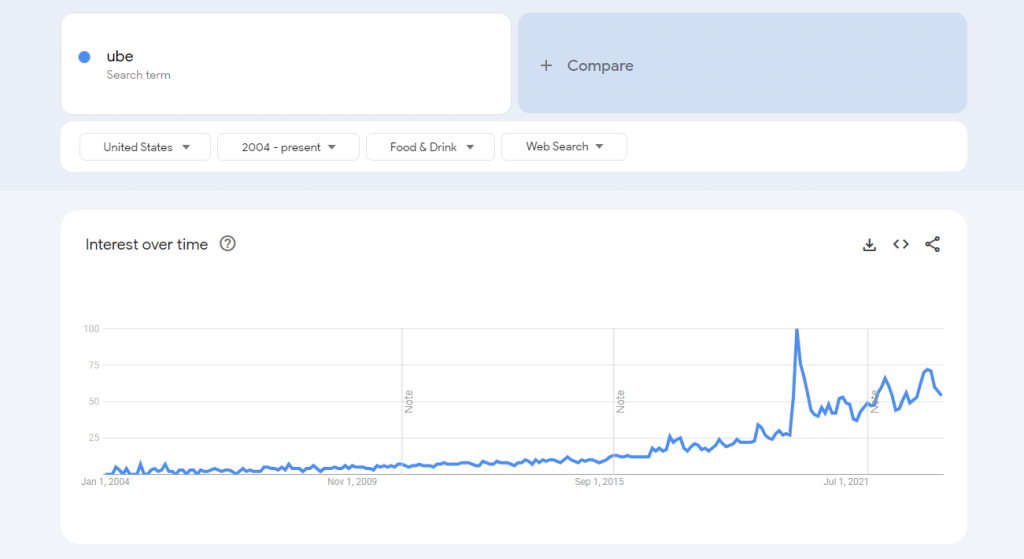
This screenshot reflects the rise in Google search traffic for ube, the bright purple yam from the Philippines that has become more popular in the USA thanks to its color.
Fungi Everywhere
In 2018 we said: Find it brined, pickled, made into pâté, made into tea, smoked, braised whole, seared, grilled, and charred. While low in protein, fungi (or heterotrophs, their preferred identity) are high in umami helping you not to miss the meat you don’t see on this trends list.
The 2023/2024 update: Google Trends shows that searches for mushrooms reached their peak in May 2020 and have remained consistent since then. This is supported by how mushrooms are showing up in coffee, functional drinks, vegan meat replacement products, and gluten-free dough. It goes beyond food, too. Mushrooms are popular in skin care products, a common sighting in jewelry and home décor (think mushroom-shaped paperweights and lamps). Plus, there’s all the psilocybin legislation and news.
We do not anticipate the fungi fascination to go anywhere but up in 2024, especially seeing how its potential as a plant-based meat alternative has barely been explored. According to GourmetPro’s 2024 food trend report (GourmetPro is an international food and beverage consulting company), only a few food manufacturers are leveraging the mushroom roots, which are dense in texture and nutrients and ideal for meat replacement.
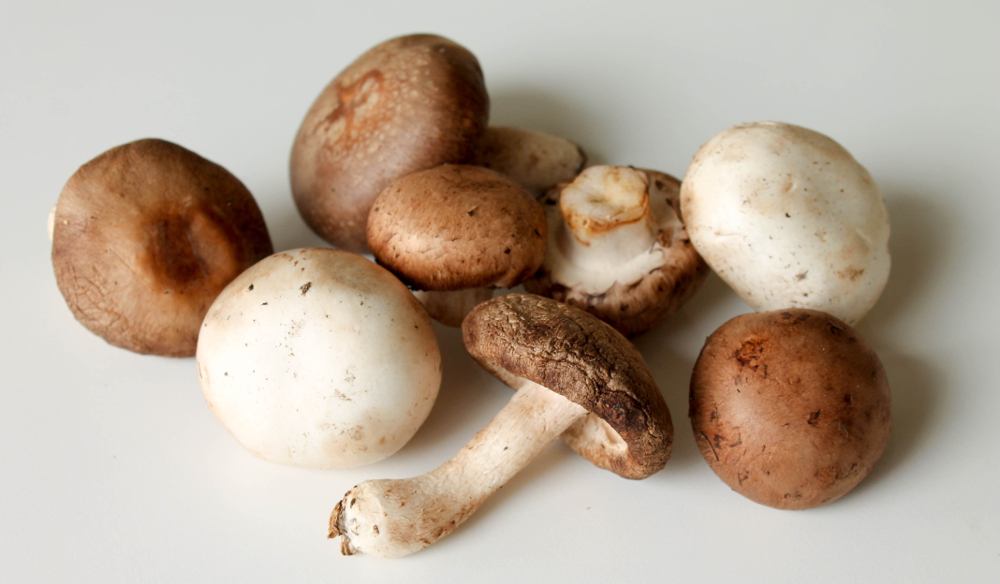
Nostalgic Food
In 2018 we said: This goes beyond retro comfort. Take the meals of yesteryear, romanticize the ingredients, and make them more delicious than the original. We are seeing nostalgic food on menus ranging from prime rib to fried bologna sandwiches.
The update: The beat goes on. Still today in 2023, news sources are calling back to comfort foods.
In March of this year, FastCasual.com reported that familiar desserts like cakes and pies are commonplace on the menu with trend-forward flavors right there alongside that comfort food.
And Food Business News reported on Archer Daniels Midland’s report and stated that “Consumers are finding more economical versions of their favorite products or re-inventions of nostalgic products and are empowered to be led to sensory experiences that are authentic to their memories, regardless of brand. Flavor inspirations include pistachio, cucumber, melon, and grapefruit. Color inspirations include pink power, magical marigold, playful blue, and pistachio green.”
Pizza AGAIN!
In 2018 we said: New and old styles of pizza as a food trend were gaining steam in 2017 (as we predicted in 2016 with the resurgence of khachapuri, a Georgian – country formerly part of the USSR – dish). Another on-trend style of pizza has to be Detroit-style pizza. Detroit pizza has a thick crust in a square shape. The style is starting to emigrate to other areas of the country. Here in Denver, you will find it at Blue Pan Pizza, and in New York City (where you must have a certain amount of bravery to introduce new styles of pizza), you can find it at Emmy Squared.
The update: Pizza is always on trend. The notable thing with this trend is how chefs and brands take it in a different direction. Currently, many manufacturers and operators are looking to plant-based versions to include cauliflower crust and nut cheeses.
But speaking at Detroit-style pizzas, according to Google Trends, there were very few searches for “Detroit-style pizza” happening in 2017 and 2018, but then in February 2021, searches took off thanks to Pizza Hut’s Detroit-style pizza limited time offer. The offer sold out quickly and was brought back due to high demand. Pizza Hut is even currently running a Detroit-style pizza LTO in Thailand.
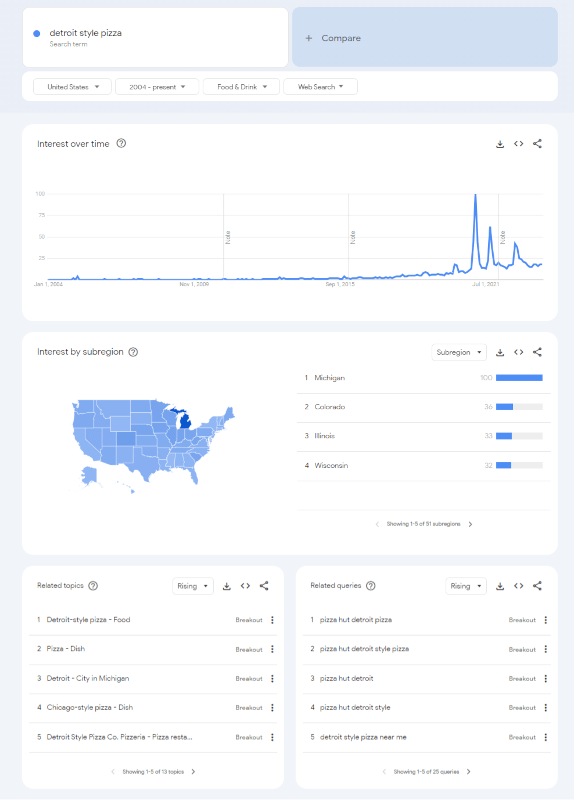
Wines Stripped Bare Naked
In 2018 we said: We thank the millennial mindset for this beverage trend. These days, many wines are coaxed into the bottle with no added yeast, no manipulation, and no chemicals. Some may consider these wines adventurous and unique, and others may consider them just plain awful tasting. The latter likely prefer the flavors produced by winemakers who have guided, maybe even manipulated, wines over the last couple of centuries.
The 2023/2024 update: You do not have to look far to find wines boasting “pure, natural, and full of complexity” and having “only the flavors found in nature.” Most major liquor stores at least have one shelf for organic and clean wines. (Though there might be some dust on the bottles.) By the way, “clean wine” refers to wine made with grapes grown using sustainable practices and produced without unnecessary additives (or not as many).
Whether or not stripped wines have reached the mainstream is not clear. According to Google Trends, web searches peaked for “organic wine” in December 2007 and searches peaked for “clean wine” in December 2010. Today, web interest seems about the same as did in 2017 and 2018, which is both less than it was in the late 2010s.
However, a quick look to celebrity culture would suggest that interest is high in wine and cocktails without added sugar and synthetic pesticides. For instance. Cameron Diaz is heavily promoting Avaline (“…organically farmed wines full of natural goodness and free from unwanted and undisclosed extras”). This article reports on 23 (23!) wines produced by celebrities. Not all organic or clean, but still…23!
The Mocktail-And-Low-Booze-In-The-Morning-Cocktail Trend
In 2018 we said: Fresh ingredients and creative combinations are taking precedence over a big hit of alcohol—that’s why today’s bar professionals are creating zero-proof and low alcohol by volume (ABV) cocktails that are easy to love on warm summer days. (Read the full article here.)
In a separate article on brunch cocktails, we also said: Now more than ever people want a memorable dining experience any time of day. Their desire for local and house-made food starts in the morning, and sometimes the morning doesn’t start until midday.
The update: Yes! Low alcohol and no alcohol all-day drinking is still happening in a big way. Take for instance this sampling of headlines from October 17, 2023:
- “Apertifs, a low-alcohol beverage, seek popularity in the Bay Area”
- “Common sense change to ‘alcohol-free drinks’ could improve nation’s health”
- “This $15 riesling is crisp, balanced and low-alcohol”
- “Can alternative yeasts lower wine’s alcohol content?”
- “The best non-alcoholic and low-alcohol wines for Sober October 2023, tried and tested”
In an October 9, 2023, press release published by The Brainy Insights, they said, “Non-alcoholic drinks market size is anticipated to grow from USD 834.3 Billion to USD 1,385.77 Billion in 10 years. Manufacturers in the market are adjusting to the new trends and developing their current product portfolios in response to customers’ rising acceptance of the no-alcohol and low-alcohol categories, which is likely to be positive for future growth. A new category of premium, complex-tasting soft drinks targeted at adult palates has emerged due to customers choosing non-alcoholic drinks.”
In other words, buckle up. The beverage industry is going to get even more interesting.
Cure What Ails You
In 2018 we said: Gut health, immunity, cholesterol, inflammation, asthma, acne, depression, constipation, and fatigue can all be remedied through food. This is not a new concept. Hindu culture has relied on Ayurvedic medicine, the practice of extending your life through diet, herbs, and yogic breathing, for thousands of years.
However, more and more chefs are focusing on overall well-being through the foods they create in the restaurant. For example, Squirrel in London now employs an on-site nutritionist (and also has a treehouse)! Then, of course, there are also nutritionists employed at health food stores and even mainstream grocers (Ralph’s for instance). Last, we are no strangers to cookbooks with a medicinal angle, but there are several out now we recommend, like The Medicinal Chef by Dale Pinnock.
The update: People are still sick, restrictive diets are in vogue, and manufacturers and restaurant operators are wise to cater to consumer demand. There’s a new word for these food and beverage products now, though – that word is “functional.”
According to the National Institute of Health, functional foods are defined as “foods that contain, in addition to nutrients, other components that may be beneficial to health.”
Glanbia Nutritionals reports that the functional drink market hovers around $50 billion. Energy drinks and sports drinks are the clear leaders in the sector with waters, dairy alternatives, and juices bringing in a pretty penny, too. It’s predicted growth will continue with more drinks focused on relaxation and immune health.
You see this same message in Whole Foods’s annual list of food trends recently released for 2024. In it, they talk about products and trending social media recipes that focus on women’s health as well as coffee and energy drinks with the addition of mushrooms, probiotics, and others.
Fermented Foods
In 2018 we said: We’re not here to espouse the health benefits of foods that promote a balanced and diverse gut microbiome. In fact, the phrase “balanced and diverse gut microbiome” rarely, if ever, passes our lips. But foods that have a positive effect on health beyond basic nutrition are a big deal right now. And we’re happy that these delicious foods, health benefits aside, are getting the food trend attention they deserve. (Read more in this article on fermentation.)
The update: See the “Cure What Ails You” section above. There’s a broad theme here. Consumers want to feel better and that means eating differently. Yes, that can mean local and sustainably farmed foods, but it can also mean more advanced scientific practices in food production. Take for instance what GourmetPro says about “precise fermentation.” This method means dairy products without the animal. While this is not the fermentation we were originally referring to in 2018 (we were talking about sauerkraut, kombucha, and kimchi), who’s to say where fermentation will lead us next.
We can say that consumers are interested. This snapshot from Google Trends shows that web searches for “fermentation” continue to rise.
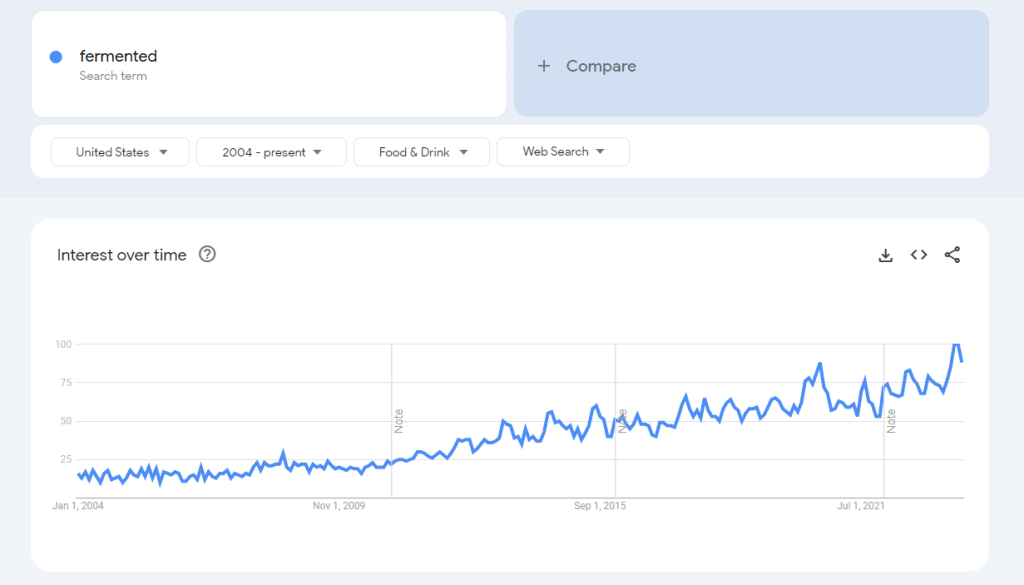
15 Flours And 12 Sweeteners Later
In 2018 we said: There are almost as many flours and sweeteners as there are grains. Will it ever stop?
The 2018 flour and sweetener movement is anything but white—take the chickpea flour socca pancake at Sqirl in Los Angeles or the cassava flour crepe from Carthay Circle in Disneyland. For sweeteners, we’re seeing the rise of rapadura sugar, coconut sugar, and brown rice syrup.
Then again, in a separate blog post about gluten-free flours we said, “Gluten-free is everywhere right now—in conversations, on the news, and on menus. Over three million people across the United States follow a gluten-free diet, and whether restaurants are catering specifically to the gluten-free lifestyle or are just making accommodations, the gluten-free movement has made an impact on the restaurant industry.” Then we went on to highlight buckwheat flour, coconut flour, and chickpea flour. Read the full post here.
The update: Like what we mentioned in the fermentation section above, research and development on the farm and in the lab continues. GourmetPro says the demand for sugar substitutes carries on, with Allulose catching the attention of many food and beverage developers.
Alternative flours, too. We hit the target by identifying buckwheat as a viable flour. In Whole Foods’s 2024 Food Trends List, they say that buckwheat will be more popular in 2024 due to its versatility as a cover crop. We also like what they say about thinking beyond simply flour to soba noodles, plant-based milk, and granola made with buckwheat.
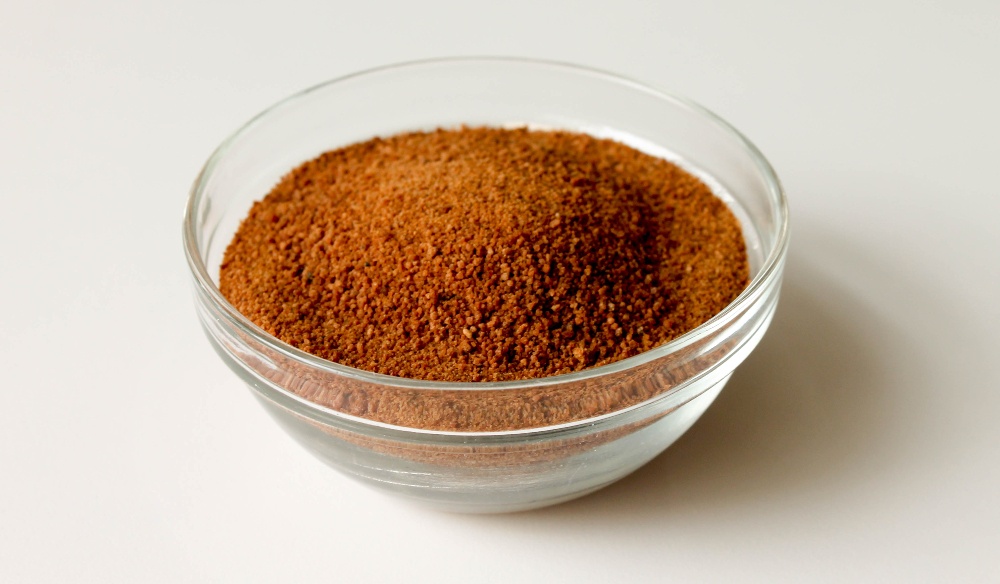
Pictured: Coconut Sugar
The New Salad
In 2018 we said: The “new veg” has been argued to be celery or maybe radicchio, but we think the “new veg” will be more of a mélange, as in the “new salad.” Here’s how it works: pick a grain, pick a green, char a veggie in coals like eggplant, beets, or butternut squash, add a seed, add a dressing (something unique like a kaffir feta ranch or fermented kombucha vinaigrette), and voila! It’s so good you won’t even miss the kale that is thankfully not on this food/beverage trend list.
The update: Re-reading our description of the ideal salad above, we couldn’t help but think of bibimbap, protein bowls, acai bowls, and other trending bowls that pack a lot of nutritional punch. Perhaps the better food trend for us to have predicted was the way this mélange is marketed to appeal to special diets: keto, plant-based, high-protein, and high-fiber, etc.
Our prediction for 2024 and beyond…more anti-inflammatory-inspired bowls.
Goodnight, Oats
In 2018 we said: On Instagram, a search for #overnightoats reveals 419,000 posts, proof that this food trend has staying power. It’s a Pinterest dream. Delicious, too, especially when you add any variety of mix-ins and/or toppings like peanut butter, banana, chia seeds, chocolate, blueberries, walnuts, coconut, and the list goes on.
The update: Without question, overnight oats had already started to see some popularity by 2018, but it didn’t stop. In fact, it peaked in February 2023. There are now 1.1+ million “#overnightoats” posts on Instagram and Google search traffic continues to rise. This screenshot from Google Trends tells the story.
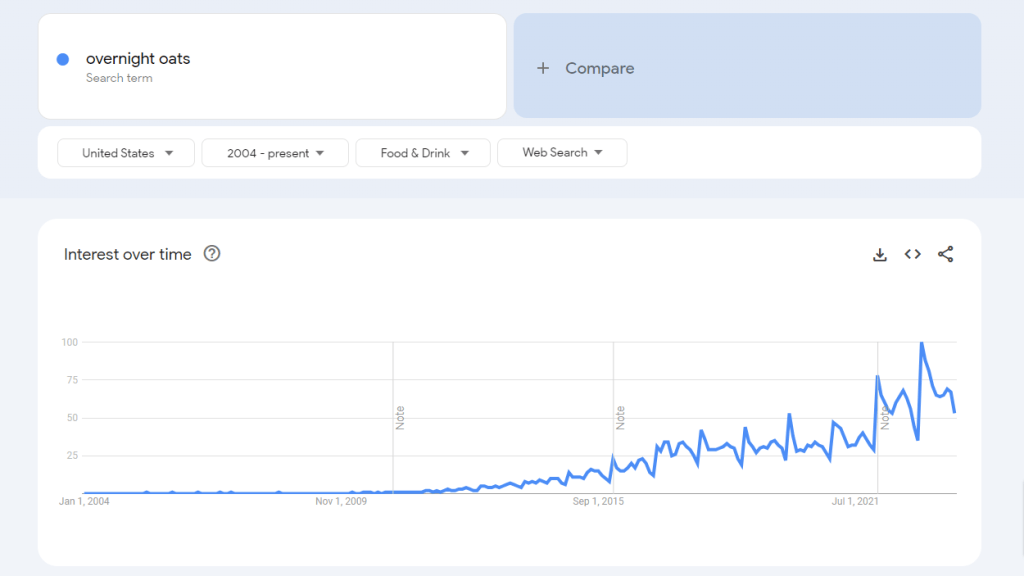
Summary
It appears most of the 2018 emerging food/beverage trends we identified have carried on strong for the last five years, especially where beverages and functional products are concerned. Looking ahead to 2024, we anticipate more growth in these areas along with more influence from viral social media trends and popular streaming shows. Food/beverage manufacturers and restaurant operators would be wise to study the media to inform product and menu development.
Thanks for stopping by and reading the Food & Drink Resources blog. Here we talk about food trends, culinary innovation, and the work of our team.
